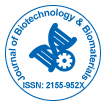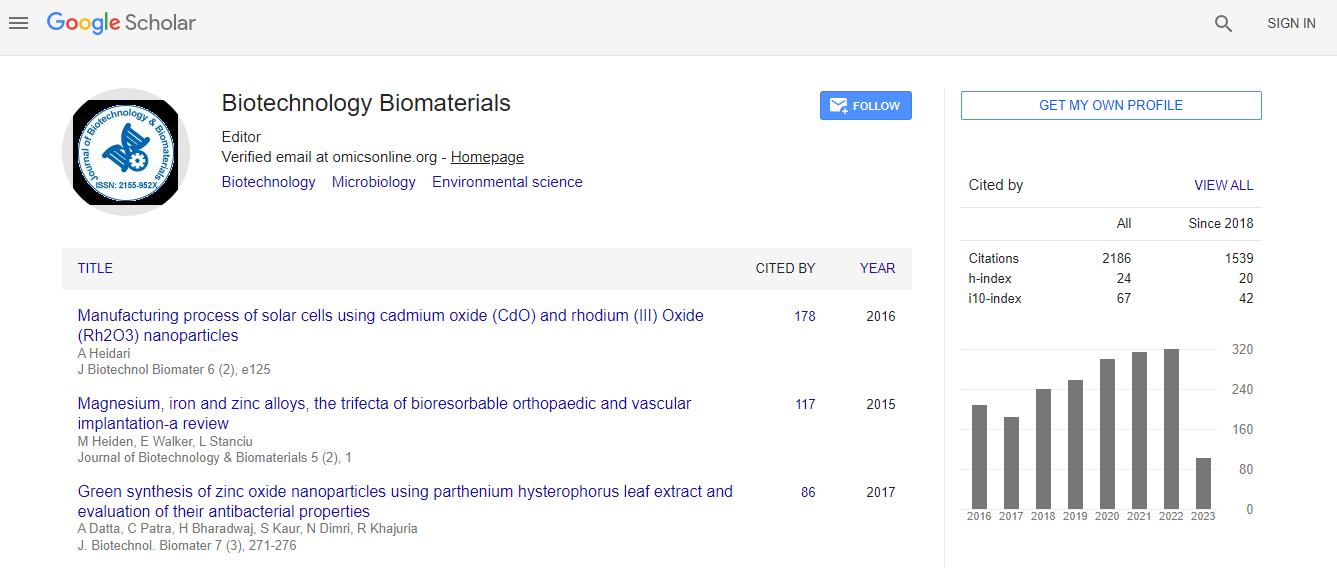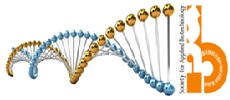Our Group organises 3000+ Global Conferenceseries Events every year across USA, Europe & Asia with support from 1000 more scientific Societies and Publishes 700+ Open Access Journals which contains over 50000 eminent personalities, reputed scientists as editorial board members.
Open Access Journals gaining more Readers and Citations
700 Journals and 15,000,000 Readers Each Journal is getting 25,000+ Readers
Google Scholar citation report
Citations : 3330
Journal of Biotechnology & Biomaterials received 3330 citations as per Google Scholar report
Indexed In
- Index Copernicus
- Google Scholar
- Sherpa Romeo
- Open J Gate
- Genamics JournalSeek
- Academic Keys
- ResearchBible
- China National Knowledge Infrastructure (CNKI)
- Access to Global Online Research in Agriculture (AGORA)
- Electronic Journals Library
- RefSeek
- Hamdard University
- EBSCO A-Z
- OCLC- WorldCat
- SWB online catalog
- Virtual Library of Biology (vifabio)
- Publons
- Geneva Foundation for Medical Education and Research
- Euro Pub
- ICMJE
Useful Links
Recommended Journals
Related Subjects
Share This Page
The use of DArTseq technology to identify new SNP and SilicoDArT markers related to fusarium resistance and the yield-related traits components in maize
26th European Biotechnology Congress
Aleksandra Sobiech
Poznan University of Life Sciences, Poland
ScientificTracks Abstracts: J Biotechnol Biomater
Abstract
Molecular analysis in maize focused on identifying new markers and QTL regions associated with loci that determine yield structure traits and Fusarium resistance. DNA analysis in the selection of parental components for heterotic crosses is an important tool for breeders, while fungi of the genus Fusarium, cause deterioration in nutritional value and forage quality due to the presence of harmful mycotoxins. The aim of this study was to identify and select new markers for maize (SNPs and SilicoDArT) linked to genes affecting yield components in maize, and markers that could be used for mass selection of fusarium-resistant varieties. The plant material consisted of 186 maize inbred lines. These lines came from two Polish experimental plots: Smolice Plant Breeding Ltd and Malopolska Plant Breeding Kobierzyce Ltd. Of the 81,602 identified SilicoDArT and SNP markers, 15,409 (1559 SilicoDArT and 13,850 SNP) significantly associated with the yield components analyzed were selected by association mapping. The largest number of molecular markers were associated with cob length (1203), cob diameter (1759), core length (1201) and core diameter (2326). Of the 15,409 markers significantly associated with the yield component traits analyzed, 18 DArT markers were selected that were significant for the same four traits in both localities. These markers were used for physical mapping. As a result of the analyses, 6 of the 18 identified markers were found to be within genes. Also, 2962 (321 SilicoDArT and 2641 SNPs) significantly associated with plant resistance to fusarium were selected, of which 7 markers were significant at the 0.001 level. They were used for physical mapping. The analysis found that two of the seven selected markers (15.097-SilicoDArT and 58.771-SNP) are located within genes on chromosomes 2 and 3, respectively. Marker 15.097 is anchored to the gene encoding putrescine N-hydroxycinnamonotransferase, while marker 58.771 is anchored to the gene encoding peroxidase precursor 72. Both of these genes may be associated with plant resistance to fusarium.Biography
Aleksandra Sobiech is a PHD student in Poznan University of Life Sciences. She graduated master study of biotechnology in 2020. On her PHD she investigated Multidimensional exploration of molecular mechanisms involved in maize (Zea mays) fusarium resistance.

 Spanish
Spanish  Chinese
Chinese  Russian
Russian  German
German  French
French  Japanese
Japanese  Portuguese
Portuguese  Hindi
Hindi 
